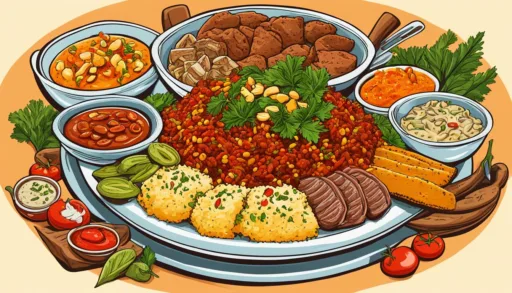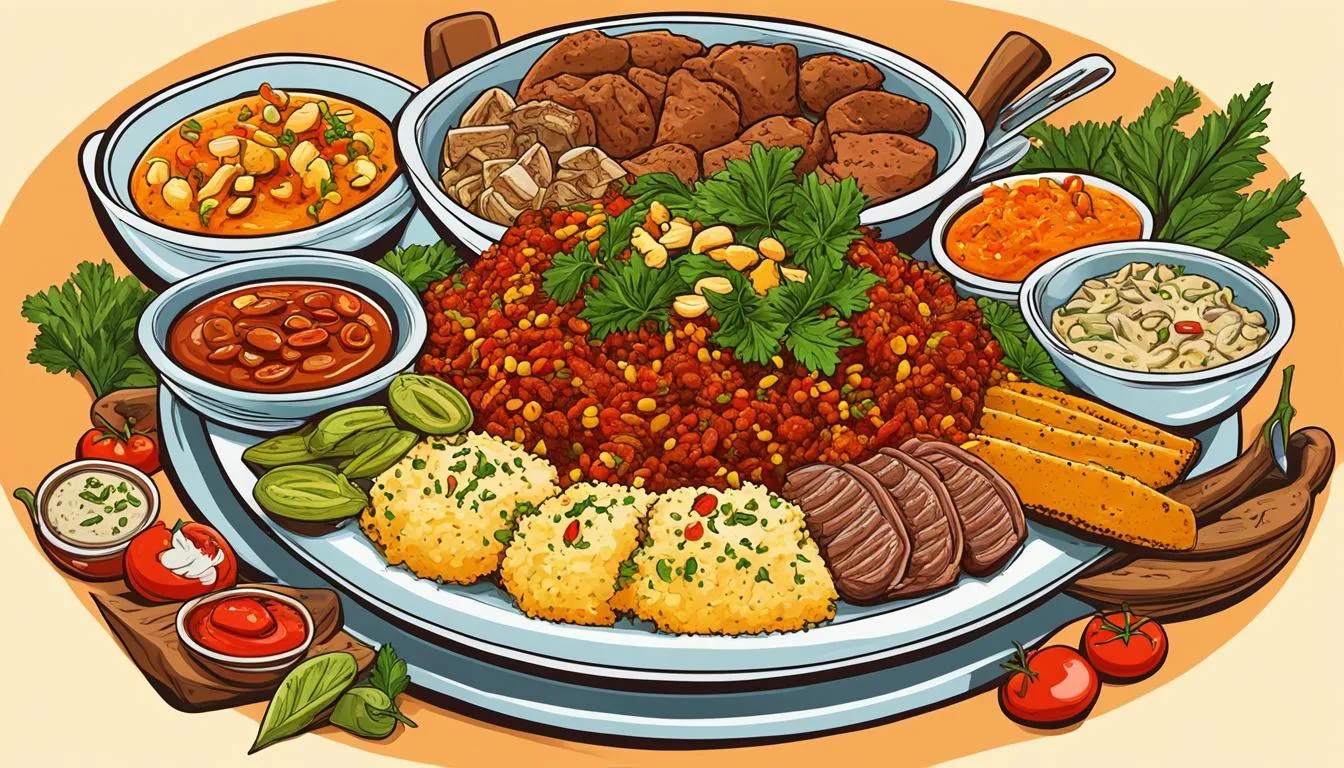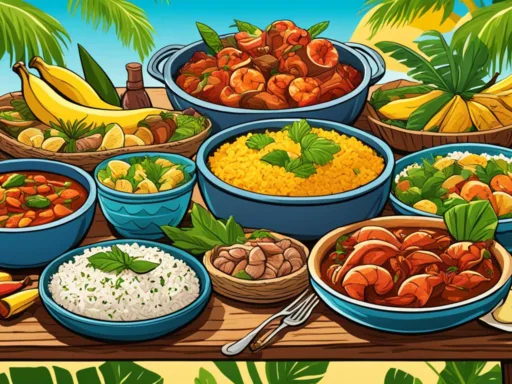For many food lovers, culinary exploration is the essence of travel – a journey through taste that leads to the heart of a culture. But what if one of the world’s most comforting staples has eluded international spotlights, hiding in plain sight in the warm embrace of Zambian households? This staple isn’t just food; it’s a tradition that unites and fortifies. Welcome to Zambia, a land not just of mesmerizing wildlife and breathtaking scenery, but also home to an enigmatic and rich culinary heritage. From the bustling markets of Lusaka to the serene villages by the Zambezi river, an array of traditional Zambian dishes are waiting to tell their stories. Our comprehensive Zambian Cuisine Guide will lead you on an epicurean odyssey to discover the real authentic Zambian food, bringing warmth to your soul and zest to your palate.
As we prepare to reveal the secrets behind dishes that have remained under the radar, imagine the taste of a culture that defines not just nourishment but identity. Get ready to be an accomplice in this culinary revelation, where each dish serves as a chapter of a storied past woven into the fabric of a nation. Whether you’re a seasoned foodie or a novice eager to dive into the heart of African cuisine, the upcoming journey through Zambia’s gastronomic landscape promises to enlighten and enliven.
Key Takeaways
- Uncover the staple of Zambian cuisine that’s an essential part of everyday life and culture.
- Get to know the diverse array of traditional Zambian dishes that span across various regions and ethnic groups.
- Explore the key ingredients and cooking methods that define authentic Zambian food.
- Learn about the significance of communal dining in Zambian culture and how it fosters unity.
- Delve into a Zambian Cuisine Guide that will transform the way you view African gastronomy.
An Introduction to Zambia’s Culinary Landscape
Zambian food culture is a rich tapestry woven with generous threads of tradition and a variety of flavors that span the nation’s diverse regions. The culinary heritage of Zambia is a testament to the combination of indigenous influences and a communal ethos that underpins every meal. Delving into the heart of this nation’s cuisine reveals an abundant use of simple yet highly nutritious ingredients, leading to an array of popular Zambian recipes.
The Staple Delights: An Overview of Zambian Cuisine
Essential to any understanding of Zambian culinary traditions is nshima, a thick porridge made from ground maize, which stands at the cornerstone of virtually every traditional meal. To truly experience the essence of the nation’s food, it is imperative to savor this staple, often accompanied by an eclectic mix of relishes and proteins that reflect Zambia’s agricultural offerings.
| Ingredient | Description | Culinary Uses |
|---|---|---|
| Maize | A versatile grain and core ingredient in nshima | Served as a porridge or side, paired with relishes |
| Leafy Greens | Includes spinach, kale, and other local varieties | Prepared as part of ifisashi or as standalone sides |
| Kapenta | Small, sardine-like fish from local lakes | Cooked dried or fresh, often served with nshima |
| Cassava | A starchy root often consumed as a snack | Roasted, fried or boiled and sometimes ground into flour |
Exploring Zambia: A Safari of Flavors
Embark on a figurative safari to explore the diverse and savory tapestry of Zambia culinary traditions. The journey traverses the land’s staple dishes to the innovative use of various proteins and greens, as well as the beloved snack of roasted cassava. Beyond these, one encounters the enigmatic chikanda, often referred to as ‘African polony,’ which adds a vegetarian mark to the food culture of Zambia. All these components contribute to a dynamic food scene that is attracting growing interest from food aficionados globally.
- Nshima: The indispensable maize-based accompaniment to a plethora of main dishes.
- Ifisashi: A dish comprising of greens in a hearty groundnut sauce.
- Kapenta: A protein-rich staple that showcases the fishing traditions of the nation.
- Roasted Cassava: A delightfully versatile snack reflecting Zambia’s root crop heritage.
- Chikanda: A vegetarian favorite providing intrigue and flavor.
Together, the popular Zambian recipes and beloved local ingredients make Zambia’s cuisine a cultural exploration worth experiencing. It speaks to the heart of the nation’s identity and offers a welcoming experience to those eager to sample the true tastes of Zambia.
The Heart of Zambian Meals: Nshima and Its Companions
Central to the Zambian dining table is nshima, a dish that weaves itself into the fabric of everyday life and stands as a testament to the nation’s rich culinary traditions. Often hailed as one of the best Zambian dishes, nshima’s simplicity belies its cultural significance, forming a vital link to Zambia’s gastronomic heritage. Behind every bite of this beloved maize-based staple, there are stories, practices, and a shared sense of identity deeply rooted within the Zambian communities.
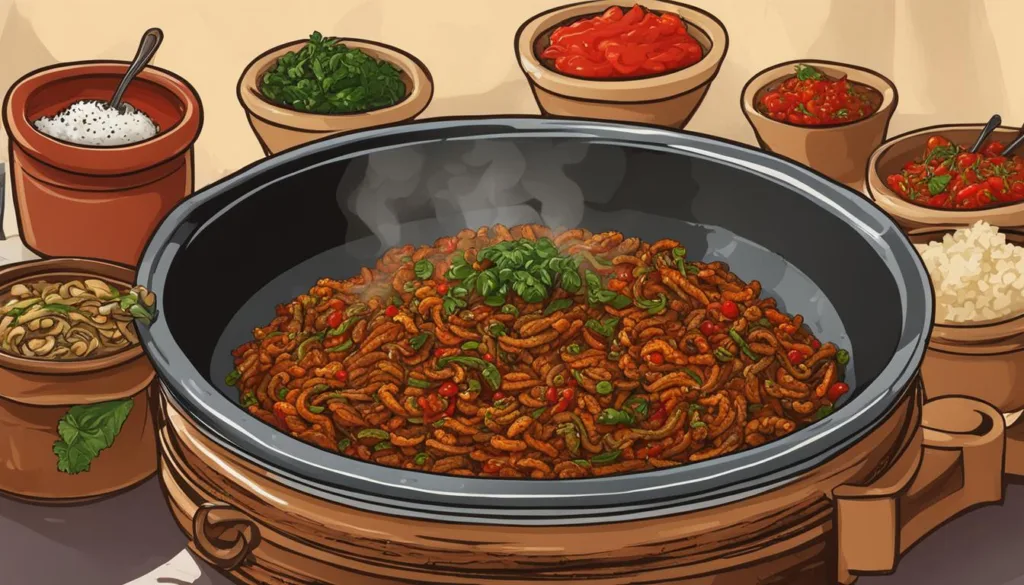
Nshima’s versatility is on display as it harmoniously pairs with an array of relishes and accompaniments. The traditional approach sees it served with succulent meat stews or a variety of nutrient-rich vegetable relishes. These combinations not only provide a balanced meal but also a dining experience that reflects the spirit of Zambian hospitality. To truly immerse oneself in the flavors of Zambia, one must sample traditional Zambian dishes where nshima plays a starring role.
- Vegetable Relishes: Rich in color and flavor, these delectable sides range from collard greens to pumpkin leaves, each offering a unique taste and a nutritional punch.
- Meat Stews: Go-to choices for protein, these stews often feature local beef, chicken, or goat, slow-cooked to tender perfection with an assortment of homegrown spices.
- Kapenta: These tiny, sardine-like fish make for a delightful pairing with nshima, bringing a salty crunch to balance the soft, subtle maize porridge.
Renowned for its ubiquity in both rural and urban settings, nshima’s prominence extends beyond the plate. It ritually brings together family and friends, fostering a sense of community that is a hallmark of Zambian culture. Whether it’s a grand celebration or a humble family meal, nshima serves as the communal cornerstone around which people gather, share, and nourish not just their bodies, but their social bonds as well.
As a culinary enthusiast or a curious traveler, to partake in an authentic meal of nshima is to delve into a rich, storied practice that is heartily recommended. It is a taste of not just the traditional Zambian dishes but also the heartbeat of a nation’s communal life.
Zambian Cuisine Guide: Unveiling Traditional Flavors
Embarking on a culinary journey through Zambia offers a palate-rich encounter with traditional dishes that signify the country’s rich cultural tapestry. African cuisine has always been about more than sustenance; it’s a celebration of flavor, sharing, and heritage, and Zambian cuisine embodies this with its distinctive tastes and communal dining experiences. Below, we delve into some authentic Zambian food that represents the heart of this vibrant culture.
Traditional Zambian Dishes You Must Try
Zambia’s gastronomic scene is a vibrant array of tastes and textures, ranging from robust meat dishes to delicate vegetarian fares. To truly grasp the essence of this cuisine, it’s essential to explore some of these traditional Zambian dishes:
- Ifisashi – A nutritious blend of greens enveloped in a savory peanut sauce. This dish is a testament to Zambian cooking tips that emphasize the use of local vegetables to create hearty, healthful meals.
- Mopane Worms – A protein-rich traditional delicacy that may surprise the uninitiated but remains a staple source of nutrition and a must-try for the adventurous foodie.
- Kapenta – These small, sardine-like fish are a local favorite. Fried until crisp or cooked into a succulent stew, kapenta is a versatile ingredient in Zambian cuisine.
- Chikanda – Often referred to as ‘African Polony’, this vegetarian delight is a unique mixture of orchid tubers and peanuts, offering a fascinating example of traditional Zambian dishes that cater to a variety of dietary preferences.
Nourishment and Community: The Role of Food in Zambian Culture
In Zambia, food is a medium that brings people together, creating a sense of belonging and shared identity. Meals are often communal affairs, reflecting the nation’s societal values. For example, the ubiquitous nshima, a maize-based staple, is not merely consumed for nourishment; it’s an integral part of Zambian social life, often serving as a central point around which families and communities gather.
Food in Zambia transcends the boundaries of simple dietary needs and nourishes the collective spirit of communities, tying people together through tradition and taste.
Eating together is a gesture of unity, and learning Zambian cooking tips can be a window into understanding the way food fortifies social structures within the country.
Chef’s Corner: Zambian Cooking Tips for Authentic Meals
Embracing the diverse and vibrant Zambian food culture can transform your kitchen into an epicurean adventure. Here we dive into the world of Zambian cooking tips to help you conjure up authentic Zambian food that resonates with the flavors of this rich culinary heritage.
Understanding the foundational ingredients and the cooking techniques is crucial for any aspiring chef or home cook looking to replicate the authentic tastes of Zambia. Let’s start with a cornerstone of Zambian cuisine—the beloved village chicken.
For that succulent village chicken dish, source free-range poultry for its richer flavor profile and firmer texture. Once you’ve seasoned your chicken and fried it to a golden brown, slow cooking with traditional spices such as paprika and chili is key to infusing the bird with those signature Zambian tastes.
Turn your attention to vegetables, where the adaptability of Zambian cooking truly shines. Vegetables like impwa, also known as African eggplants, are popular for their health benefits and versatility in Zambian dishes. Below is a simple guide on how to best prepare this ingredient:
| Cooking Method | Preparation Steps | Recommended Spices |
|---|---|---|
| Steaming | Chop impwa and steam until tender | Light seasoning with salt and a touch of ginger |
| Baking | Slice impwa, coat with oil and bake until crisp | Experiment with a blend of cumin and coriander |
| Frying | Dice impwa and fry until golden | Finish with a sprinkle of smoked paprika |
Zambian meals are more than just sustenance; they are a cherished ritual, a cornerstone of community, and a way to express affection through hearty and nurturing dishes. So, whether you’re a seasoned cook or new to Zambian cuisine, remember: the most important ingredient is a generous pinch of love and respect for the culture and traditions that make these meals truly special.
Fish and More: The Versatility of Kapenta in Zambian Recipes
A hallmark of the diet in Zambia, kapenta have secured their place within the nation’s culinary heart. Their small size belies the significant role they play in some of the most popular Zambian recipes. Whether fried to a crisp or simmered in a rich stew, kapenta bring a burst of flavor to every dish they grace.
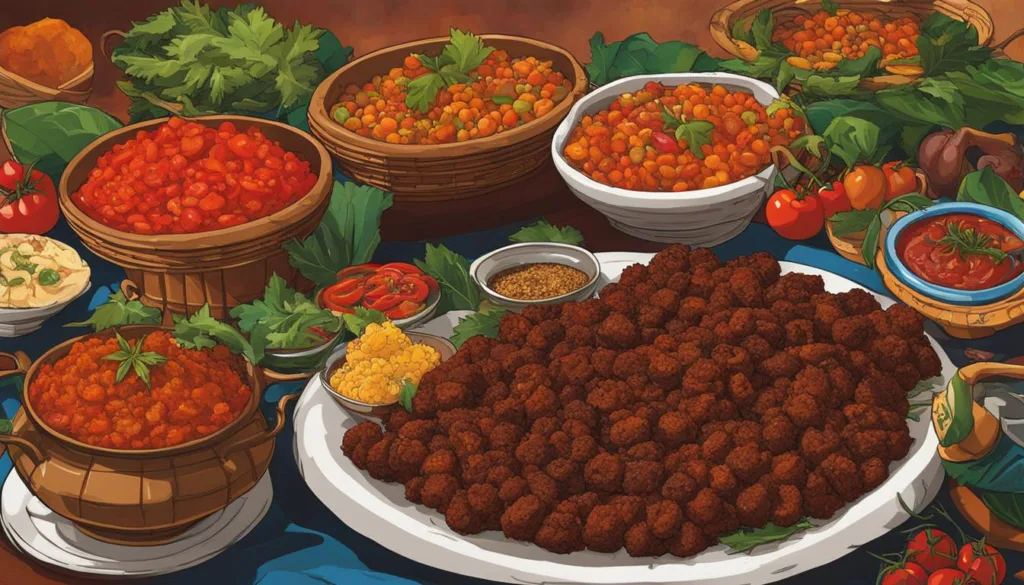
From Lake to Plate: Kapenta Cooking Techniques
Kapenta, the treasured catch from Zambia’s glistening waters, is prepared with much anticipation. Invariably, the process starts with a thorough clean, followed by a soaking period that primes them for cooking. Traditionally, these fish are then fried until they achieve a golden brown hue that’s utterly irresistible. Alternatively, stewing kapenta allows it to absorb a variety of spices, creating a delectable dish that stands out among the best Zambian dishes.
Pairing Ideas: Complementing Dishes for Kapenta
When considering how to serve kapenta, one must appreciate its distinctive flavor propensities. The inherent piquancy is perfectly balanced with the mildness of Zambia’s beloved nshima, resulting in a harmonic dining experience. Another common pairing involves rustic bread, which sops up the flavorful sauces that often accompany kapenta. These combinations are just a few examples of how kapenta contributes to the rich tapestry of Zambian recipes.
Discovering kapenta is to engage with the spirit of Zambian cuisine in its purest form. As an ingredient, its versatility is a testament to Zambia’s innovative approach to culinary expression—a true cultural treasure.
Ifisashi: A Zambian Vegetable Stew Journey
Delving into the world of authentic Zambian food, one cannot overlook the significance of Ifisashi, a delectable stew that is just as nutritious as it is delicious. This crown jewel among traditional Zambian dishes has a way of not only filling stomachs but also warming hearts across the country.
True to its roots in Zambian culinary tradition, Ifisashi is a harmonious blend of leafy vegetables and a sumptuous groundnut sauce. The choice of greens often includes kale, spinach, and occasionally the locally cherished kalembula—sweet potato leaves. These greens are then simmered in a rich medley of tomatoes, onions, and a selection of optional spices, culminating in a rich, creamy dish that is both versatile and incredibly satisfying.
- Greens: Kale, Spinach, Kalembula (Sweet Potato Leaves)
- Base: Rich Groundnut Sauce
- Additional Ingredients: Tomatoes, Onions
- Optional Spices: To taste (chili, ginger, garlic, etc.)
- Perfect Pair: Nshima (Maize Porridge)
Whether you prefer your Ifisashi mild or spicy, the dish adapts to your palate, cementing its place in the authentic culinary landscape of Zambia. Renowned for its versatility, it pairs exceptionally well with the ubiquitous nshima, creating a meal that resonates with the flavor profiles beloved in Zambia.
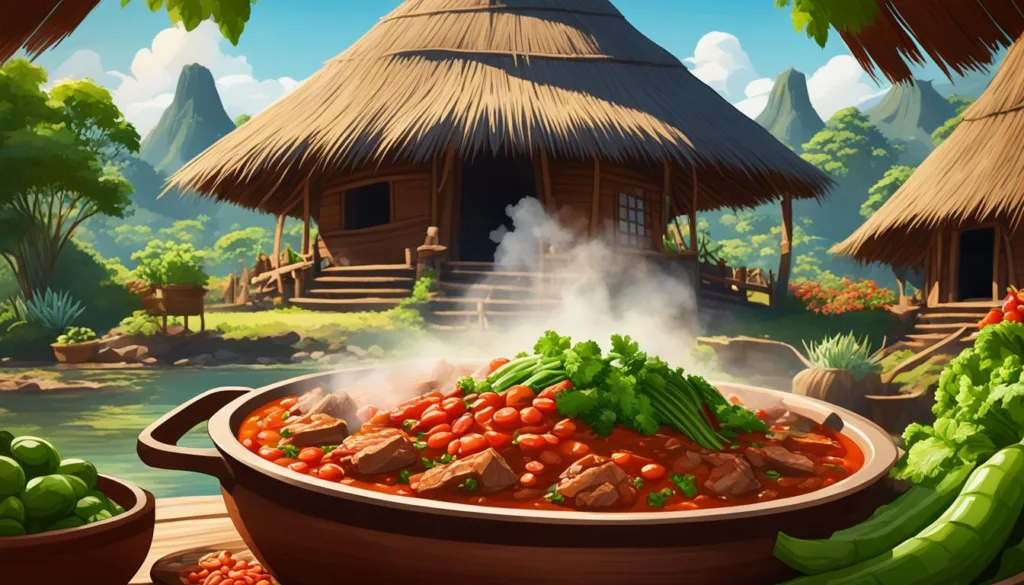
“Ifisashi is more than just food; it embodies the communal essence and wholesomeness that is central to Zambian cuisine.”
As you embark on your culinary explorations, ifisashi stands as a testament to the rich tapestry of flavors that traditional Zambian cuisine has to offer. It’s a must-try for anyone yearning for an authentic taste of Zambia – a true journey through Zambian kitchens and a vibrant celebration of Zambian heritage.
Chikanda: The Vegetarian Favorite from Zambia
Among the wide array of traditional Zambian dishes, Chikanda stands out as a vegetarian delight, earning its place as a staple of vegetarian Zambian food. Known colloquially as ‘African Polony,’ Chikanda’s unique texture and taste have made it a beloved dish throughout the nation and an ambassador of Zambian culinary innovation on the global stage.
Made with a blend of finely ground orchid tubers and groundnut flour, this unlikely combination is mixed with an array of spices which are then cooked to achieve its signature jelly-like consistency. The versatile nature of this dish allows it to be eaten as a cold snack or a cherished appetizer. An emblem of the nation’s biodiversity and gastronomic creativity, Chikanda represents a sustainable and flavorful choice for those preferring plant-based options.
Here’s a quick guide to Chikanda’s main ingredients and preparation:
| Main Ingredients | Preparation Method |
|---|---|
| Orchid tubers | Grind tubers into fine powder |
| Groundnut flour | Mix with orchid powder and spices |
| Spices (chili, salt, etc.) | Cook the mixture until firm |
| Water or stock | Blend until it reaches a dough-like consistency |
Chikanda transcends its traditional roots through its adaptability and ability to integrate into modern cuisine while remaining a quintessential aspect of Zambia’s gastronomic identity. Locals and travelers alike cherish this vegetarian delicacy, making it one of the most recognizable traditional Zambian dishes far beyond its origin. Its widespread appeal is a testament to the ingenuity and richness of Zambian cuisine, as it continues to be a source of culinary pride and joy.
Discover Village Chicken: A Rich Taste of Rural Zambia
Embodying the heart of rural Zambia’s culinary essence, Village Chicken stands as a testament to the authentic flavors that make up some of the best Zambian dishes. Unlike its commercial counterparts, this free-range delicacy boasts a richer, more robust flavor, defining what many consider to be among the most memorable traditional Zambian dishes.
Preparation of Village Chicken is steeped in tradition, beginning with seasoned frying that coats the chicken in a symphony of local spices. The next stage of simmering incorporates a variety of indigenous ingredients such as onions, garlic, tomatoes, and vibrant chili, creating a dish that is deeply flavorful and wonderfully aromatic.
Village Chicken captures the soul of Zambia, offering a culinary journey with every bite that transports you to the country’s vibrant plains and bustling village markets.
This dish is not only a feast for the taste buds but also a cherished part of the fabric that weaves together Zambian communities, representing a shared history and collective identity.
| Ingredient | Role in Dish | Flavor Profile |
|---|---|---|
| Free-range Chicken | Main protein | Rich, robust |
| Onions and Garlic | Aromatic base | Savory, pungent |
| Tomatoes | Gravy foundation | Bright, tangy |
| Chili | Heat element | Spicy, warm |
| Local Spices | Seasoning | Earthy, complex |
Whether accompanied by the ubiquitous nshima or served alongside sides such as rice or garden-fresh vegetables, Village Chicken holds a place of honor on the Zambian dinner table. It’s a communal meal, a celebration of culture, and above all, an unmissable culinary delight for anyone eager to experience the full spectrum of Zambia’s gastronomic heritage.
Impwa: Experiencing Zambia’s Take on Eggplants
In the rich tapestry of Zambian cuisine, Impwa, or African eggplants, stand out as a remarkable produce, both for their culinary versatility and nutritional value. Zambia’s take on eggplants goes far beyond the typical foliage found in global grocery aisles. These indigenous vegetables bear a distinct taste, slightly more bitter than their global counterparts, but they are highly prized for their richness in fiber, vitamins, and their adaptability in various Zambian eggplant recipes.
From Garden to Table: Cooking Methods for Impwa
Impwa can be expertly prepared through a range of cooking techniques that bring out their unique flavors. Whether it’s frying them to a golden perfection, baking them for a healthier twist, or gently steaming to preserve their authenticity, these methods celebrate authentic Zambian food traditions. Each process ensures that the natural taste of impwa shines through, allowing for a true Zambian culinary experience, from garden-fresh to a well-prepared table delicacy.
Health Benefits of Bitter Tomatoes in Zambian Cuisine
The culinary journey of Zambian dishes does not neglect wellness, which is evident in the inclusion of impwa in their diet. Known locally as ‘bitter tomatoes’, these eggplants are lauded for their health-promoting properties. The natural bitterness is suggestive of the valuable compounds they contain, aiding in digestion and enhancing overall health. Integrating these vegetables into one’s diet through various Zambian-inspired dishes not only tantalizes the palate but also contributes to a nutritious lifestyle.
FAQ
What are some of the essential dishes in a traditional Zambian cuisine guide?
Traditional Zambian cuisine is varied and flavorful, with essential dishes including nshima, which is a maize meal staple, ifisashi, a nutritious vegetable stew with groundnut sauce, and village chicken, which offers a taste of the rich, rural traditions. Also, don’t miss out on trying kapenta, a small fish from Zambian lakes, and chikanda, often called African polony and a hit among vegetarians.
What makes Zambian food culture unique?
Zambian food culture is characterized by its emphasis on communal dining and usage of simple, locally sourced ingredients. Meals like nshima promote a shared experience, while the use of maize, leafy greens, and fish like kapenta reflect the nation’s agricultural resources and traditions. The approach to cooking is often straightforward yet innovative, ensuring each dish bursts with natural flavors.
Can you recommend popular Zambian recipes for someone new to the cuisine?
Absolutely! For someone new to Zambian cuisine, some great starters to try would be nshima paired with ifisashi or a savory meat stew, fried or stewed kapenta, and sweet potato leaves cooked in peanut sauce. Not to forget, chikanda makes for a delightful vegan-friendly recipe. These dishes provide a well-rounded introduction to the spectrum of flavors found in Zambia.
What are the best Zambian dishes to experience authentic Zambian food?
To experience authentic Zambian food, one must try nshima, Zambia’s staple food, usually served with vegetable relishes or a meat stew like village chicken. Additions such as ifisashi and dishes containing kapenta or mopane worms provide a deep dive into the country’s authentic culinary culture. Lastly, tasting chikanda will complete a truly Zambian gastronomic experience.
What are some valuable Zambian cooking tips for creating traditional meals?
When cooking Zambian meals, use fresh, locally-sourced ingredients for the best flavor, and don’t shy away from traditional cooking methods, such as simmering stews over an open fire. For nshima, achieving the right consistency is key – it should be firm enough to hold its shape. With vegetable dishes, balance is vital; they should be well-seasoned but not overpowering so as to complement nshima or other staples.
How is kapenta used in Zambian recipes, and what does it pair well with?
Kapenta is a versatile ingredient in Zambian cuisine, used in both fried and stewed forms. It pairs wonderfully with a thick tomato and onion sauce, and its salty, fishy flavor complements the blandness of nshima. It can also be paired with dishes that include sweet potatoes or pumpkin leaves for added nutrition and flavor contrast.
What is ifisashi, and how is it integral to Zambian food traditions?
Ifisashi is a traditional Zambian stew consisting of green leafy vegetables cooked in a savory groundnut sauce. It’s a staple that showcases Zambia’s love of vegetables and its ingenious use of nuts to create a rich, creamy flavor. This dish is integral to the nation’s food traditions for its nutritional value and widespread cultural acceptance.
What is unique about vegetarian Zambian food, particularly chikanda?
Vegetarian Zambian food emphasizes natural ingredients and traditional processing methods. Chikanda, in particular, is unique due to its use of wild orchid tubers and groundnuts, resulting in a meat-free dish that’s high in protein and has a distinctive, satisfying texture akin to that of a cold meatloaf, making it an excellent vegetarian delicacy.
What differentiates village chicken in Zambian cuisine from regular chicken dishes?
Village chicken, or free-range chicken, is cherished in Zambian cuisine for its richer flavor and firmer texture compared to broiler chickens. The traditional cooking methods, which often involve braising with local spices and ingredients, give the dish an authenticity and depth of flavor that celebrates the agrarian lifestyle of rural Zambia.
How are impwa, or African eggplants, prepared in Zambian recipes?
Impwa can be prepared in various ways, reflecting the versatility of this ingredient. They can be fried, baked, or steamed. When frying, it’s common to add onions, tomatoes, and a touch of chili to enhance their flavor. In some regions, impwa leaves are also used in traditional cooking, showcasing a zero-waste culinary philosophy and the importance of indigenous vegetables in Zambian cuisine.
Can you explain the health benefits associated with consuming impwa in Zambian dishes?
Impwa, also known as African eggplants or bitter tomatoes, are a great source of dietary fiber, vitamins, and minerals such as potassium and iron. They are low in calories and high in water content, making them a healthy choice for those looking to maintain a balanced diet. Their potential benefits include aid in digestion, better heart health, and they might also contribute to better blood sugar control.
